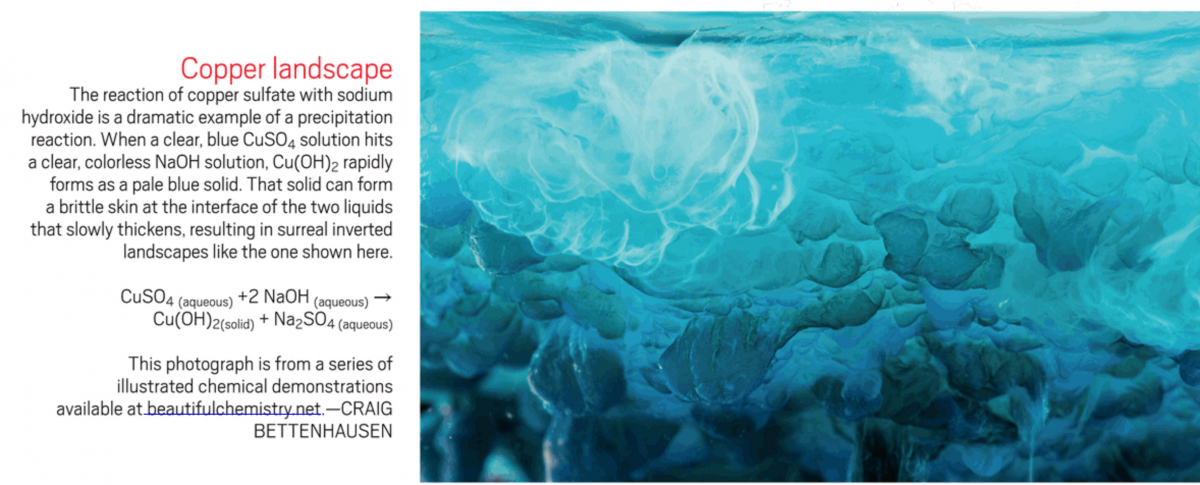adapted by M. J Simpson from a lab originally by S. F. Sontum, K. Jewett and R. Sandwick
Learning goals: work collaboratively with a lab partner, follow instructions to complete a chemistry experiment, collect experimental data, formulate logical conclusions based on experimental results
Introduction
Much as a cook uses recipes to guide her/him in preparing dishes, chemists use chemical equations as ways of expressing the results of chemical reactions. Sometimes it is more descriptive to use the ions involved in a reaction rather than the ionic compounds. For example, to express that hydrochloric acid reacts with sodium hydroxide to give water and sodium chloride, we could write:
Molecular equation: HCl(aq) + NaOH(aq) → H2O(l) + NaCl(aq)
The above equation is fine in some ways, but in actuality NaOH and HCl solutions do not contain NaOH and HCl molecules, and there are no NaCl molecules in the solution after the reaction occurs. The better description for this reaction is:
Total ionic equation: H+(aq) + Cl–(aq) + Na+(aq) + OH–(aq) → Cl–(aq) + Na+(aq) + H2O(l)
Net ionic equation: H+(aq) + OH-(aq) → H2O(l)
The first equation is called the total ionic equation, while the second is termed the net ionic equation. A net ionic equation summarizes the changes that have taken place as a result of a chemical reaction.
Background
The solubility of a substance in a solvent is the maximum amount of the substance that can be dissolved in a given amount of solvent. While there is no exact definition for the boundary between soluble and not soluble, a general guide might be:
SOLUBILITY TERM
> 0.1 M Soluble
0.01 to 0.1 M Moderately soluble
< 0.01 M Slightly soluble
Some guidelines have been prepared to help estimate a compound’s solubility. These are written in a manner where statements above other statements have priority. For example, an alkali metal carbonate is soluble since “all alkali metals (#2) are soluble” have priority over “All carbonates are insoluble.” [There are exceptions that are not included here. (See textbook)]
Solubility Rules:
- All nitrates (NO3-) and acetates (C2H3O2-) are soluble.
- All salts of alkali metals and NH4+ are soluble.
- All common halides (Cl-, Br–, I–) are soluble, except those of Ag+, Pb2+, Cu+, Hg22+
- Hydroxides (OH-) are insoluble except for Na+, Ca2+, and Ba2+.
- All sulfates (SO42-) are soluble, except BaSO4 which is slightly soluble, and CaSO4 and Ag2SO4, which are moderately soluble.
- All carbonates (CO32-) and phosphates (PO43-) are insoluble.
Procedure
Note: perform this experiment with a partner, but be sure to observe the tests together.
Make up the following standard solutions:
50.0 mL of 0.10 M KI(aq) from KI(s)
25.0 mL of 0.10 M CuCl2 (aq) from CuCl2 ● 2H2O (s)
50.0 mL of 0.10 M H2SO4 (aq) from 1.00 M H2SO4(aq)
25.0 mL of 0.10 M NaOH (aq) from 1.00 M NaOH(aq)
50.0 mL of 0.10 M Na2CO3 (aq) from Na2CO3(s)
Three test solutions will be prepared for you: 0.10 M AgNO3, 0.10 M BaCl2, and 0.10 M Co(C2H3O2) 2.
To determine how to prepare a solution from a solution of higher concentration, use the formula: Ci Vi = Cf Vf
where:
Ci = initial concentration of higher concentration solution
Vi = initial volume of the higher concentration solution
Cf = final concentration (of the diluted solution)
Vf = final volume of the diluted solution (volume of the initial solution plus water)
Tests for chemical reactions:
For each of the solutions you prepared, test each solution with the following test solutions:
0.10 M AgNO3
0.10 M BaCl2
0.10 M Co(C2H3O2) 2
0.10 M Na2CO3 (the solution you prepared)
A test involves taking 5 mL of your solution and adding 3 – 5 drops of the test solution. Make observations in the table on the worksheet.
Things to note:
(a) a change of color;
(b) a separate phase is formed;
(c) any other change.
Report
Complete the worksheet for your lab report. Optional survey.
The following procedure may help you when writing a net reaction for any chemical reaction.
- Determine the principal forms present of each reactant in solution.
- Determine the principal forms present after the reaction has occurred.
- Write a balanced equation for the reaction.
- Cross out reactants and products that do not change (the spectator ions).
Example: Mix HNO3 solution + KOH solution
Principal substances before reaction: H+, NO3-, K+, OH-
Principal substances after reaction: NO3-, K+
Product formed: H2O
Net reaction: H+(aq) + OH-(aq) → H2O (l)

